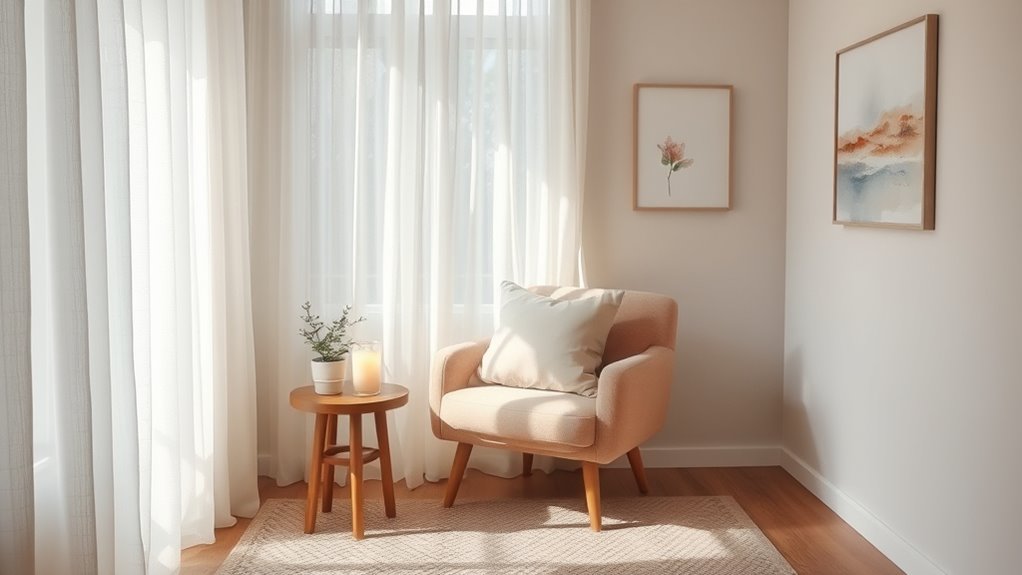To create a calm corner for dementia-related anxiety, choose a quiet, clutter-free space with natural light and soft, soothing colors like pastels or gentle greens. Add cozy seating, familiar objects, and sensory elements such as calming scents or gentle sounds. Incorporate personal items and maintain easy access for safety and comfort. Keep the environment simple, organized, and welcoming—focusing on familiarity and tranquility. Keep exploring for detailed tips to make it truly effective.
Key Takeaways
- Choose a quiet, accessible area with natural light and minimal noise to promote calmness.
- Incorporate soft, cozy seating, calming colors, and simple decor to create a soothing environment.
- Add familiar personal items and calming sensory elements like gentle sounds and scents for reassurance.
- Ensure the space is clutter-free, well-organized, and safe, with clear pathways and easy access.
- Use consistent routines and visual cues to help familiarize the individual and encourage regular use.
Understanding the Importance of a Calm Space
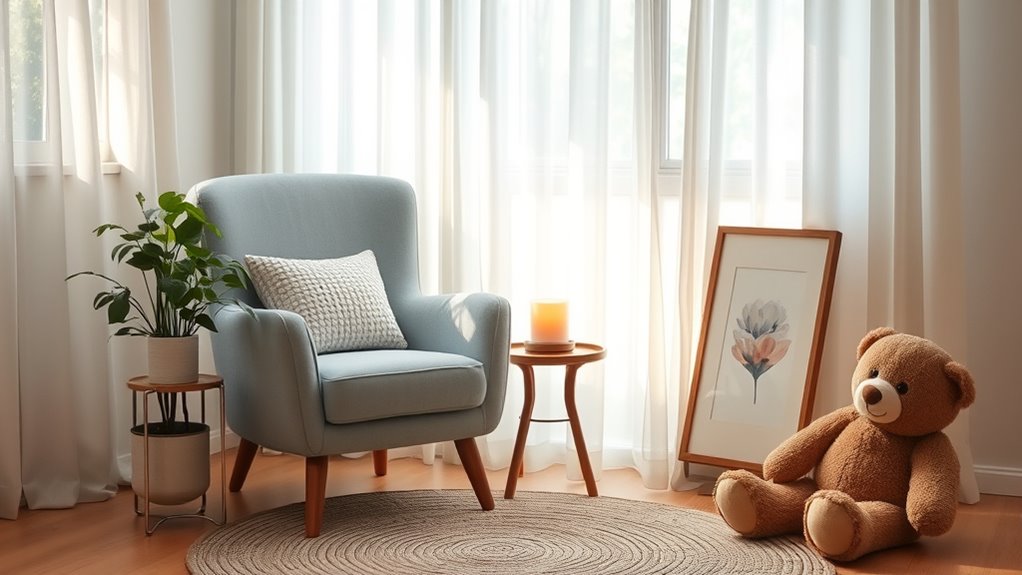
Creating a calm space is essential because it provides a safe haven where individuals with dementia can feel secure and reduce feelings of anxiety. When you incorporate meditation techniques, you give them tools to calm their mind and body, helping to manage stress. Calming music also plays a crucial role, providing soothing sounds that promote relaxation and emotional stability. This dedicated space acts as a refuge during moments of confusion or agitation, giving your loved one a sense of control and comfort. By intentionally designing this area with peaceful elements like gentle music and simple relaxation techniques, you create an environment that nurtures peace and reassurance. Incorporating appropriate equipment such as comfortable seating and soft lighting can further enhance the calming atmosphere. Creating a calm environment can positively impact their overall well-being by reducing agitation and promoting emotional stability. Using familiar objects and sensory elements can deepen the sense of comfort and familiarity within the space. Additionally, incorporating therapeutic elements such as aromatherapy or textured items can further promote relaxation and emotional well-being. Including personalized items that hold sentimental value can also strengthen the connection to the space and enhance feelings of safety. A calm space becomes a fundamental part of managing dementia-related anxiety, fostering a sense of safety and well-being.
Choosing the Ideal Location for the Corner
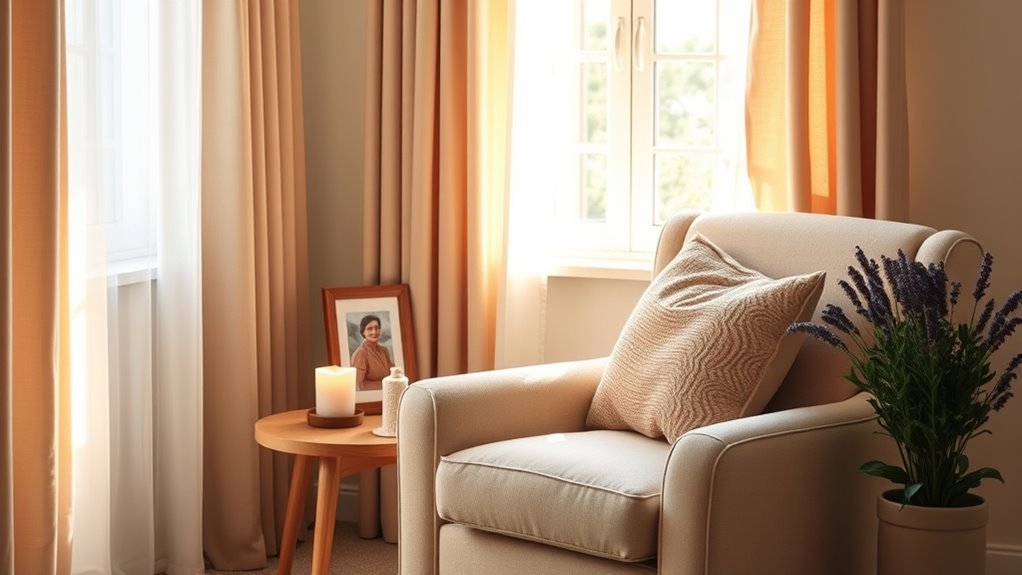
When selecting a spot for the calm corner, look for a quiet, low-traffic area to minimize distractions. Make sure it has plenty of natural light, which can help create a soothing atmosphere. Also, prioritize accessibility and safety to guarantee your loved one can easily reach and use the space without risk. Incorporating retail store hours into the planning can help ensure the space remains available at convenient times for your routine or visits. Additionally, integrating cultural intelligence into the design can help tailor the space to your loved one’s preferences and needs. Considering lighting control options can further enhance the calming environment by allowing adjustments to natural and artificial light levels, which is especially beneficial for managing Glycolic Acid benefits in skincare routines.
Quiet, Low-Traffic Area
Choosing the right spot for your calm corner is essential to guarantee it effectively reduces anxiety. You want a quiet, low-traffic area where your loved one won’t be disturbed or startled. This space should minimize noise, helping with noise reduction, and provide visual privacy to prevent overstimulation. Avoid hallways or busy rooms and instead look for a corner tucked away from main walkways. A secluded spot fosters a sense of safety and calmness. Use the table below to assess potential locations:
| Location Options | Advantages |
|---|---|
| Unused corner in a bedroom | Quiet, personal space, noise reduction |
| Small alcove near the living room | Visual privacy, easy access |
| Behind furniture or a partition | Blocks noise, creates secluded atmosphere |
| Near a window but away from door | Natural sound buffer, privacy |
| Away from kitchen or TV area | Less noise, calmer environment |
Additionally, incorporating sound-absorbing materials can further enhance the tranquility of the chosen space, helping to manage running dry and mental fatigue. Using appropriate materials such as acoustic panels or soft furnishings can significantly improve noise control and create a more peaceful environment. Introducing calming textures and colors can also promote relaxation and comfort within the space. To optimize the environment, consider adding soothing lighting that avoids harsh brightness and supports a calming atmosphere.
Natural Light Availability
Natural light can considerably enhance the calming effect of your loved one’s designated space. When choosing the location, prioritize areas with ample natural light and direct sunlight exposure, as these can help regulate mood and reduce anxiety. Natural light creates a warm, inviting atmosphere that feels less clinical and more comforting. Aim for a spot near windows or glass doors that allow sunlight to filter in naturally. Avoid areas with harsh or uneven lighting, which may cause discomfort or agitation. Consistent sunlight exposure throughout the day can also help reinforce circadian rhythms, promoting better sleep and overall well-being. Incorporating natural lighting into the space supports mood regulation and can reduce feelings of confusion or distress. Understanding the importance of environmental factors can guide you in creating a more supportive and soothing environment for your loved one. By selecting a space with ideal natural light, you create a peaceful environment that supports your loved one’s emotional stability and sense of security. Ensuring proper lighting quality can further enhance the calming atmosphere and reduce discomfort. Additionally, advances in automation technology are making it easier to control lighting levels and schedules, further improving the environment.
Accessibility and Safety
Selecting a location for the calm corner requires careful attention to accessibility and safety to guarantee your loved one can use it comfortably and securely. Pick a spot close to main living areas to prevent confusion, but away from busy pathways to minimize overstimulation. Ensure the area is free of tripping hazards and has sturdy furniture. Incorporate assistive technology like voice-activated devices or motion sensors to support independence. Proper caregiver training helps you monitor safety and respond quickly if needed. Use this table to guide your choice:
| Consideration | Tips | Examples |
|---|---|---|
| Accessibility | Easy to reach, minimal obstacles | Low shelves, clear pathways |
| Safety | Remove hazards, secure furniture | Non-slip mats, rounded edges |
| Technology & Support | Incorporate assistive tech, training | Sensors, caregiver education |
Additionally, selecting a vacuum with HEPA filtration can improve air quality in the space, making it more comfortable and healthier for your loved one.
Selecting Soothing Colors and Decorations
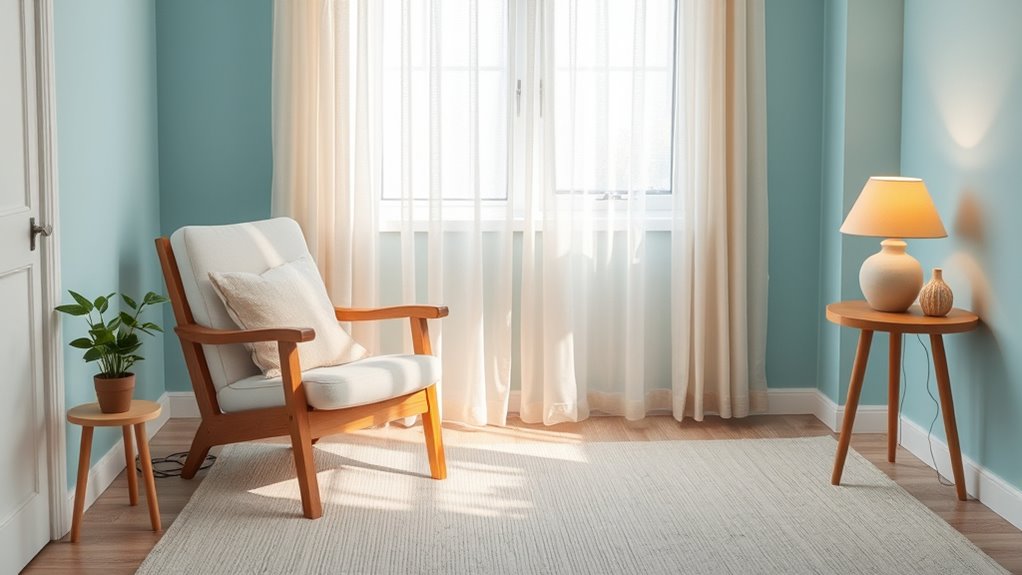
When designing a calming corner for someone with dementia, using soothing colors and decorations can considerably reduce anxiety. Color psychology shows that soft, muted tones like gentle blues, greens, or pastels create a peaceful environment. These colors help to calm the mind and lessen agitation. Choose decorative accents that are simple and non-intrusive, avoiding busy patterns or overly bright hues. Natural elements like plants or artwork with calming imagery can enhance the serenity. Keep decorations minimal to prevent overstimulation. The goal is to create a space that feels safe and comfortable, so every color and decorative piece should promote relaxation. Thoughtful selection of these elements helps foster a sense of calm and security for your loved one.
Incorporating Comfortable and Safe Seating Options
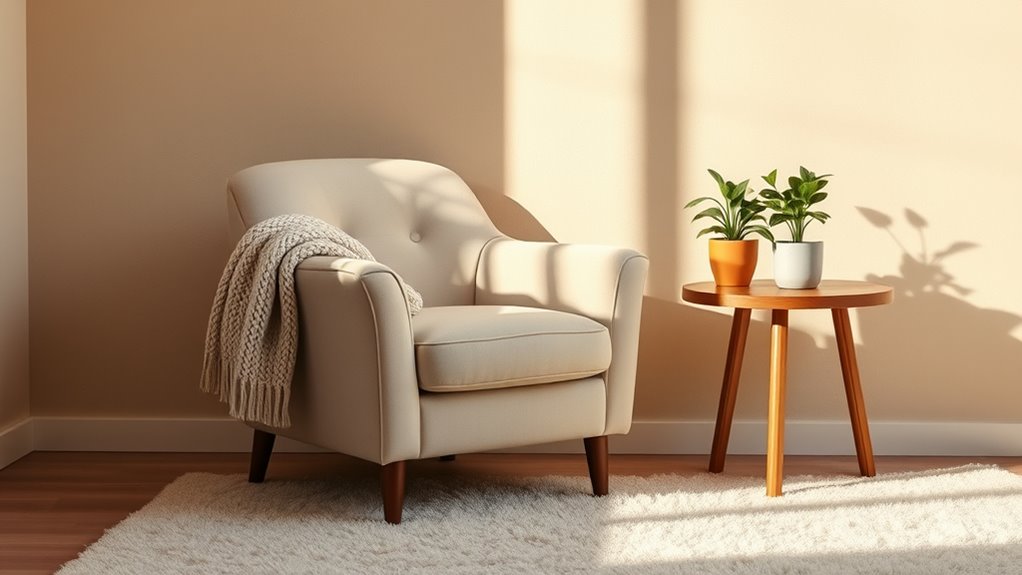
To make certain your loved one feels secure and comfortable in the calming corner, it’s essential to incorporate seating options that prioritize both comfort and safety. Choose chairs or sofas with sturdy frames, supportive cushions, and non-slip feet to prevent accidents. When arranging furniture, ensure there’s enough space to move freely without obstacles, reducing the risk of falls. Position seats so your loved one can easily see the entrance and any calming elements, fostering a sense of security. Incorporate lighting control to keep the area well-lit but adjustable, avoiding harsh glare or shadows that could cause confusion or anxiety. Proper furniture arrangement combined with adjustable lighting helps create a peaceful, safe environment where your loved one can relax confidently.
Adding Sensory Elements for Relaxation
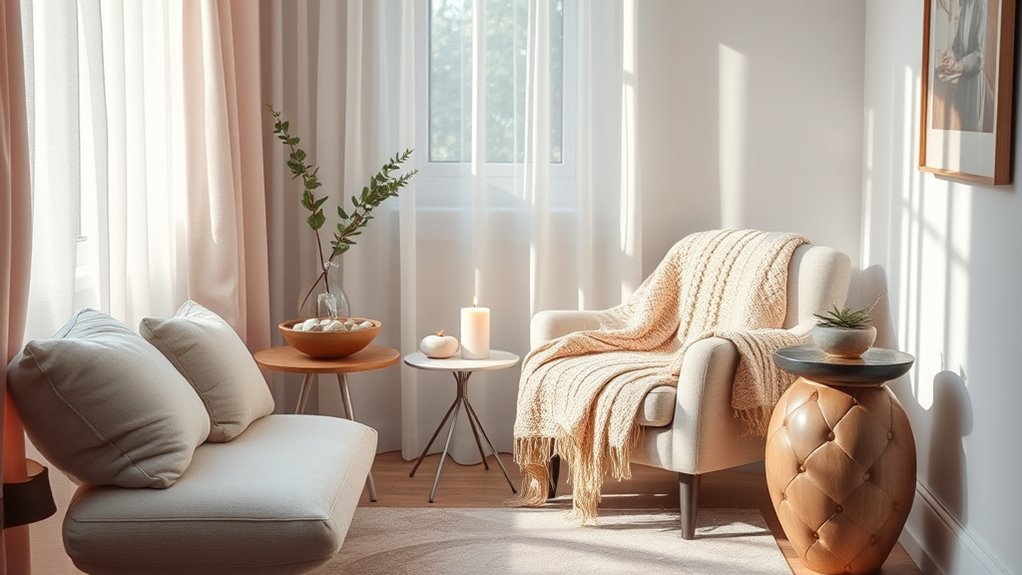
Adding sensory elements to the calming corner can considerably enhance relaxation and reduce anxiety for your loved one. Sensory stimulation, like soft textures, gentle lighting, or calming sounds, creates a soothing environment that minimizes stress. Incorporate calming sounds such as gentle music, nature sounds, or white noise to help your loved one feel more at ease. These sounds can mask unsettling noises and promote a peaceful atmosphere. Use items like textured fabrics, calming scents, or tactile objects to engage their senses without overstimulation. The goal is to create a balanced space that gently stimulates the senses, providing comfort and reassurance. Be mindful of individual preferences, and adjust sensory elements accordingly to maximize relaxation.
Including Personal Items and Familiar Objects
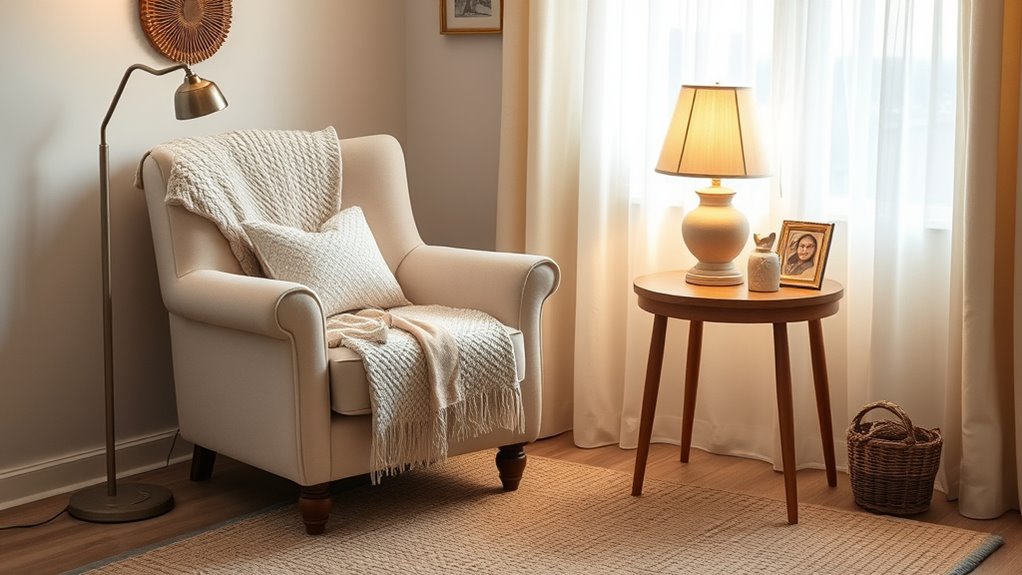
Including personal items and familiar objects in the calming corner can deepen the sense of comfort and security for your loved one. These familiar objects evoke positive memories and create a welcoming environment. Incorporate items like photos, favorite blankets, or keepsakes that have sentimental value. Such personal touches help your loved one feel connected to their identity and past. To help visualize ideas, consider this table:
| Personal Items | Familiar Objects | Placement Ideas |
|---|---|---|
| Family photographs | Favorite mug | Place at eye level for easy viewing |
| Childhood keepsakes | Vintage clock | Keep within arm’s reach |
| Sentimental jewelry | Favorite pillow | Use in the corner for comfort |
| Personal letters or cards | Favorite book | Keep accessible for reading |
These items foster familiarity and reduce anxiety effectively.
Ensuring Accessibility and Ease of Use
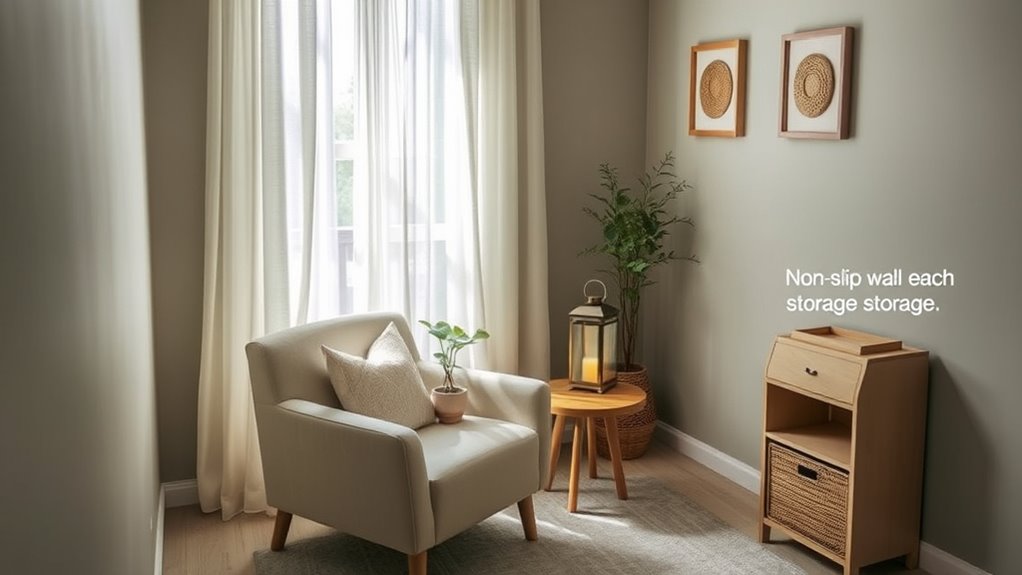
To make the calm corner truly accessible, you need clear pathways and signage that are easy to understand. Comfortable seating options encourage relaxation without causing frustration, while simple, familiar decorations help create a reassuring environment. Paying attention to these details guarantees the space is welcoming and easy to navigate for everyone.
Clear Pathways and Signage
Clear pathways and signage are essential for creating a safe and reassuring environment for individuals with dementia. Well-designed wayfinding aids help guide them smoothly through the space, reducing confusion and anxiety. Use clear, simple visual cues such as arrows, symbols, or color-coded signs to indicate directions and destinations. Keep pathways unobstructed and wide enough for easy navigation, avoiding clutter that can cause trips or falls. Signage should be placed at eye level and use large, legible fonts to be easily readable. Consistency in signs and cues helps reinforce understanding and familiarity. By ensuring clear pathways and intuitive visual cues, you create a space where individuals feel confident and secure, promoting independence and reducing stress.
Comfortable Seating Options
Providing comfortable seating options is essential for creating a calming environment for individuals with dementia. When selecting chairs, prioritize ergonomic design to support proper posture and reduce strain. Chairs with armrests and firm, supportive cushions promote seating comfort and stability, making it easier for your loved one to sit and stand safely. Choose chairs that are easy to get in and out of, with a stable base and appropriate height. Avoid overly soft or complex furniture that might cause confusion or discomfort. Ensuring accessibility means selecting seating that meets their needs without requiring effort or causing frustration. Well-designed, comfortable seating encourages relaxation and helps reduce anxiety, making the calm corner a safe and welcoming space for your loved one.
Simple, Familiar Decorations
Choosing decorations that are simple and familiar helps create a calming environment free from confusion or overstimulation. Use decorative accents like familiar photos, artwork, or everyday objects that your loved one recognizes. Avoid clutter by selecting a few meaningful pieces rather than many. Seasonal themes can add a gentle touch of change without overwhelming, such as a welcome autumn leaf or a cozy winter scene. Keep decorations at eye level and within easy reach to ensure accessibility. Steer clear of overly bright colors or busy patterns that might cause discomfort. By focusing on familiar, uncomplicated decorations, you help your loved one feel safe and grounded in a space that promotes relaxation and reduces anxiety.
Maintaining a Peaceful and Clutter-Free Environment
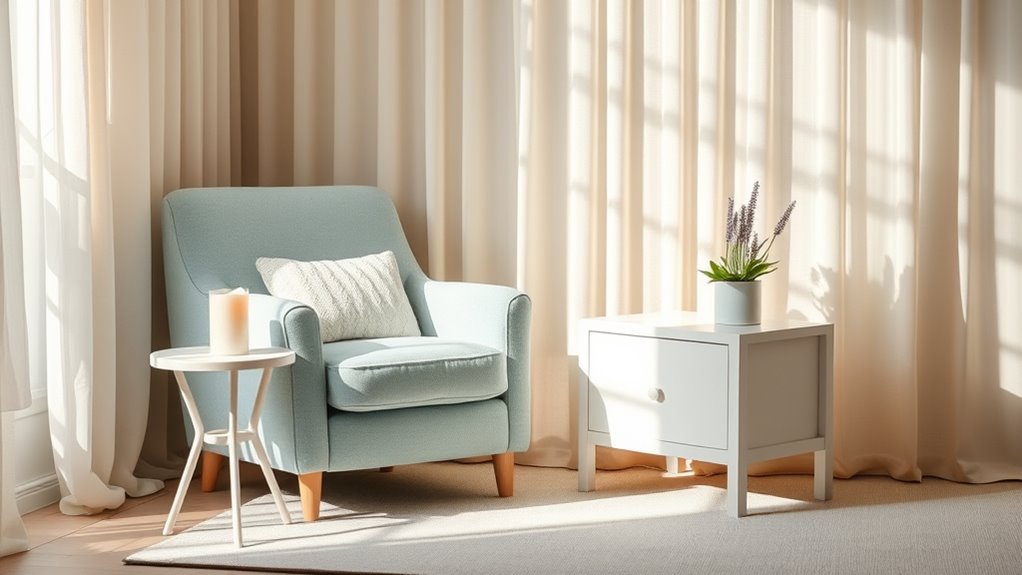
To create a calming space for someone with dementia, it’s essential to keep the environment peaceful and free of clutter. Noise reduction plays a crucial role in minimizing distractions and preventing sensory overload. Use soft background sounds or white noise machines to mask sudden loud noises that can cause anxiety. Clutter management helps create a sense of order and safety; remove unnecessary items and keep essential belongings within easy reach. Arrange furniture to allow clear pathways, avoiding obstacles that could cause confusion or falls. Keep surfaces clear and organized, so your loved one isn’t overwhelmed by visual chaos. A tidy, quiet environment promotes relaxation and makes it easier for them to focus on calming activities or rest. Maintaining this peaceful setting supports their overall comfort and well-being.
Encouraging Regular Use and Personalization

Encouraging regular use and personalization of the calming space helps your loved one feel more connected and comfortable. To do this effectively, consider these steps:
- Incorporate music therapy by playing favorite or soothing tunes to create a familiar atmosphere.
- Use aromatherapy benefits by diffusing calming scents like lavender or chamomile to promote relaxation.
- Personalize the space with familiar objects, photos, or mementos that evoke positive memories.
- Establish a routine, encouraging your loved one to spend time in the space daily, helping them associate it with comfort.
Frequently Asked Questions
How Can I Involve the Person With Dementia in Creating the Calm Corner?
You can involve the person with dementia in creating the calm corner through participatory design, making certain their preferences guide the process. Ask for their input on colors, textures, and calming objects, and encourage family involvement to guarantee comfort and familiarity. This approach helps them feel valued and in control, reducing anxiety. By actively including them, you create a space tailored to their needs, promoting a sense of security and well-being.
What Safety Considerations Are Essential for the Calm Space?
You need to focus on safety considerations like hazard prevention and accessibility features. Remove sharp objects, secure rugs, and make sure good lighting to prevent falls. Use easy-to-reach storage and simple layouts so the person with dementia can navigate safely. Regularly check for hazards and keep the space clutter-free. These steps help create a safe, calming environment that promotes independence and reduces anxiety.
How Often Should the Calm Corner Be Refreshed or Updated?
Your calm corner needs regular refreshes to stay as soothing as a gentle breeze. You should update the decor and make seasonal adjustments at least every few months, or when the space begins to feel stale. This keeps the environment engaging and comforting. By doing so, you create a space that feels fresh and inviting, helping dementia patients feel secure and relaxed, no matter the time of year.
Are There Specific Sensory Tools Recommended for Dementia-Related Anxiety?
You should include sensory tools like soothing textures, such as soft blankets or plush toys, and calming scents like lavender or chamomile in your calm corner. These tools help reduce dementia-related anxiety by providing gentle stimulation and comfort. Always choose items that are safe, non-toxic, and easy to clean. Regularly update and rotate these sensory tools to keep the environment engaging and effective in soothing your loved one.
How Can I Encourage Consistent Use of the Calm Corner?
Ever wonder how to make the calm corner a go-to space? You can encourage consistent use by applying motivational strategies like gentle reminders and positive reinforcement. Establish a routine, so your loved one associates the space with comfort and safety. Reinforce this habit regularly, making the calm corner a familiar refuge. Over time, these routine reinforcement tactics help build a sense of security, encouraging them to seek out the calm corner when needed.
Conclusion
Creating a calm corner gently nurtures a sense of peace and comfort, making each visit a soothing escape. By thoughtfully choosing a cozy, personalized space, you help foster moments of tranquility and gentle connection. Remember, this special spot isn’t just about easing worry — it’s about creating a welcoming haven where warmth and serenity naturally blossom. With time and care, your calm corner becomes a cherished retreat, softly enhancing daily life with quiet joy.
